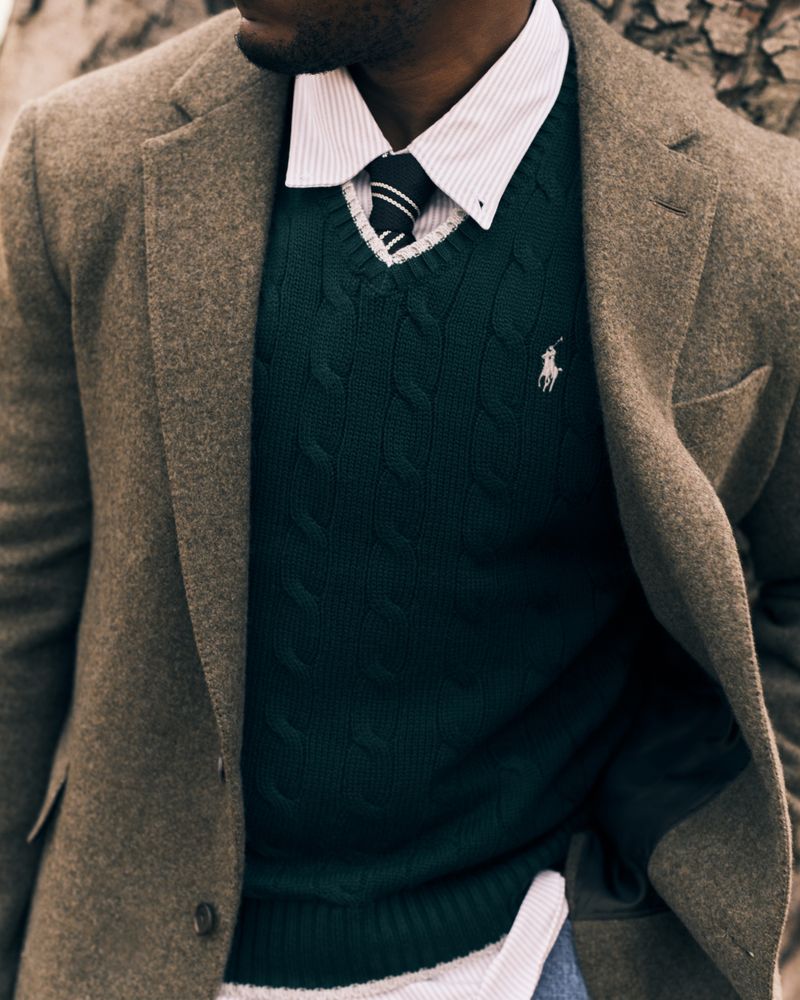THE JOURNAL

As worn by MR PORTER Team members. From left: Juan Lopez, Farid Hounkponou and Alfred Humphries
Ivy style is enjoying something of a revival. But unlike its close aesthetic cousin, prep – which famously has a handbook – there’s something more arcane about the Ivy League look. The latter was incepted at elite American colleges in the early 20th century. And much like the dining clubs and secret societies that proliferated at the same intuitions, Ivy style became a fraternity unto itself, with membership communicated through subtle sartorial signals. For instance, a natural-shouldered blazer with a three-roll-two button stance, an Oxford-cloth shirt with a perfectly frayed collar or a necktie that quietly communicates insider status.
Ivy continues to have a secret-handshake quality that’s made it both endearing and mysterious to the present day, as well as a major influence on contemporary brands including Polo Ralph Lauren, Sid Mashburn, Drake’s and BEAMS PLUS. And because it always pays to do your homework, we’ve dialled a few experts to decode the qualities that make Ivy “Ivy”.
01. Stay soft and shrug your shoulders


Perhaps no value is more important across the Ivy spectrum than that of tailored jackets having unpadded shoulders – so much so that the aesthetic has also been called “the natural shoulder look”. By dispensing with the built-up padding or roping that marked English tailoring, Ivy jackets gained a nonchalance that carried over into the rest of the look: think of the soft, unlined shirt collar, the flat-front chino and the repp tie worn slightly askew.

But all that ease was the result of hard training. “The Ivy League colleges put an enormous emphasis on sports,” says veteran menswear writer and True Style author G Bruce Boyer. “A lot of these students were pretty well built to begin with, and they didn’t need highly constructed clothing.”
Fortunately, bulging biceps or toned pectorals are not a requirement for engaging in Ivy’s laid-back charms today.
02. No darts
Another Ivy obsession is the “sack suit”, in which the tailored jacket is free of the vertical incisions, called “darts”, that give shape to the chest. As Boyer relates, this was not so much an Ivy innovation, but rather the result of clinging to an earlier style of tailoring before the genre grew more shaped and sculptural in the 1920s with the advent of the “English drape cut”, which gave men a V-shaped silhouette with strong shoulders and a nipped waist.
“The sack suit has been around for a long time,” Boyer says. “And people like Brooks Brothers, who invented that look and were the main distributors of it here, didn’t take up the drape cut. There was a longer tradition of the sack suit and they kept to it.”
Take a note: Ivy honours tradition, wherever it comes from.
03. Fray away


If there’s any quality that isn’t Ivy, it’s newness. Clothes were meant to look lived-in or, even better, passed down. So prized is wear-and-tear that Columbia professor Edward Said famously witnessed two of his classmates at Princeton attacking their brand-new button-down shirt collars with sandpaper, an anecdote recounted in his 1991 memoir Out Of Place.

Constantine Valhouli, the author of Miles, Chet, Ralph & Charlie: An Oral History Of The Andover Shop, connects this virtue back to the Anglo character that shaped so many of the schools and the campus shops that served them. “That comes from an older British tradition of wearing things until they’re just gorgeously worn, even tattered,” he says. “It goes without saying that things had to be made beautifully and fit beautifully, just worn beyond the point of propriety.”
Needless to say, that point is decided by the wearer – and until then, the clothing should continue to be worn with full confidence.
04. Codes over logos
While Ivy abhors a logo, the style has quiet visual signifiers of its own. Chiefly, the monogram and the club tie, which came with their own unspoken rules.
“The bad signifiers were logos, or anyone’s initials who are not your own – unless they’re a member of your family,” Valhouli says of one particular prohibition. “It’s one thing to wear your uncle or your father’s monogrammed shirts. They can be passed down.”
Club ties, meanwhile, signalled membership in closed societies through specific sigils whose importance would be lost on the public at large. “I think there is a quiet, understated sense of status for those who can read club neckties that don’t have anything except a symbol recognised by other members of the club,” Valhouli says.
And should your club tie literacy prove lacking, you can always start your own.
05. Roll with it


Another idiosyncratic detail of the Ivy blazer is the three-roll-two, in which a jacket has three buttons, but only the centre is intended to be fastened. As a result, the top button discreetly “rolls” under the lapel, semi-visible if at all.
As Boyer relates, this is actually a fashion trend – albeit one from the Edwardian era, where three- or even four-button jackets were the norm. Young men feeling dandyish would forgo the top button to show off more of the necktie and gradually began turning it down to show off even more woven silk real estate.

“I think it at first was just a more expressive way of dressing for guys who were into it. And then at some point, it becomes the norm,” he says.
Enough of a norm that the three-roll-two has broken out of Ivy and often features on Neapolitan tailoring today.